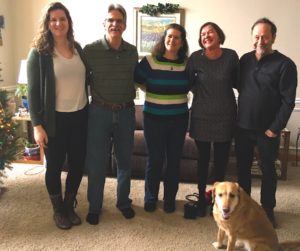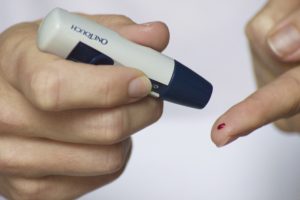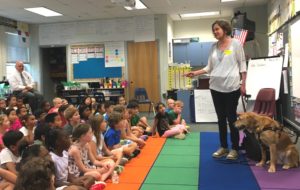Mondays with Mike: Lacrosse balls and muffulettas
December 23, 2019 • 10 Comments • Posted in UncategorizedI write from the lobby of the LePavillon Hotel in New Orleans’ Central Business District. Beth and I are 15,000 steps into our first day in New Orleans and 60 degrees feels pretty good. We just polished off a half a classic muffuletta sandwich from Central Grocery.

From left to right, Kate, Chuck, and Elisse. You know the rest of ’em. Thanks to Rebecca for snapping the picture.
We are sans Whitney, as loyal readers would know—and boy am I glad we didn’t bring Whitney on this NOLA adventure. It’s hard even on a sighted human guide weaving around on narrow, uneven sidewalks, dodging drunk phone walkers. But at least we human guides get muffulettas and Sazeracs out of it.
Right now, Whitney is probably counting her lucky stars. We dropped her at her retirement home in Pennsylvania Saturday. Like lots of these things—at least for me—the self-manufactured, anticipated dread about the event was much worse than reality.
In fact, it was as joyful as a separation of its like could be. Beth and flew to Baltimore on Friday, and we spent the evening catching up with our friend Rebecca. Rebecca and I go back to high school days. We were partners in crime of a sort—actually, partners in adventure. And we’ve reached the point in life where we look at each other and recognize that we’re the only other people to have witnessed certain important passages in one another’s lives.
Rebecca drove us the hour north to Pennsylvania and it felt good right away. Green. Hilly. Quiet.
We drove up a windy road up a hill—then up a steep driveway. Beth put the harness on Whitney for the last time—she wanted her new people to see her working, at least once.
Once we hit the door, well, we were off. There was Elisse, who guest blogged; her husband Chuck, their newly married daughter Kate, her husband Luke, and Elisse’s 96-year-old mother. We learned volumes about each other in a matter of minutes. Including the fact that Chuck is a mechanical engineer with a distinctly non-conventional engineering job: He and his colleagues engineer giant arena shows for the likes of Cher and other mega-acts.
And Whitney was off harness and off leash. She whimpered for a second, and we knew it was time for the lacrosse ball. For most of her life with us, Whitney would fetch that ball until I stopped. In fact, sometimes I had to hide it for fear she’d run herself to death.
But for the last year, she’d fetch it once and then walk off.
Well, between Luke and me, we coaxed the old Whitney back.
By the time we gave Whitney a last scratch, and carried her leash and harness out to Rebecca’s car, she was happy as a clam.
And so was I. With that, I leave you a a couple tastes of New Orleans


